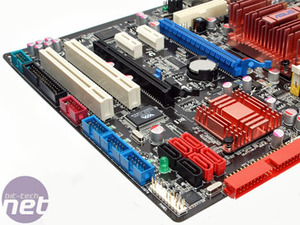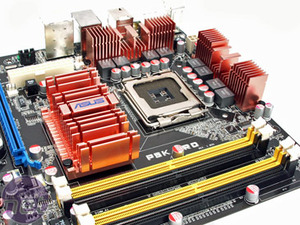Board Layout
It’s worth noting firstly that the board is thinner than what we’re used to so this has had a consequence on component positioning. Straight away you’ll notice the ATX connector is slap bang in the middle of the board which is far from the best place to put it – now the thick ATX cable has to be dragged across the board which means it gets in the way of everything. Not only that, but Asus has dotted the 4-pin CPU fan connector and another 3-pin fan connector right by these, just compounding an already irritating problem.Given the board size there’s nowhere else to put it though; the memory slots are right up against the edge on the side it would normally sit. Sure, Asus could have made the board a bit wider but that adds to its cost, however there are plenty of other boards in the market at the same price that don't have this problem.
The entire board is decked out in aluminium capped solid capacitors, and a far more appealing colour scheme than the brown-yellow Asus P5K-SE for example.
Everything is dictated by the eight phase CPU power regulation system that’s unparalleled in a board of this cost. Because of the way the EPU is currently designed, this is required though, however the benefit of this is that it makes for a more capable, yet cheaper system. The memory and northbridge get a single power phase as well, although the environmentally sealed ferrite cored Chokes and mosfets used for the CPU power are of higher quality.


While there are no heatpipes, the heatsinks used on both northbridge and southbridge are very capable, although we did find the nothbridge heatsink gets a little hotter than competitor boards because it’s buried between the memory and CPU socket. There are heatsinks on all eight CPU power phases too, and even though between these and the northbridge heatsink they are quite encompassing of the socket, they aren’t tall enough to really interfere. Replacing them is also much simpler because they're not tied in by heatpipes.
We were initially concerned that the northbridge heatsink was just held down by two push-pins; previously on the Asus P5N SLI we found a similar system where the heatsink could be easily rocked back and forth, losing the contact and making the chipset overheat – thankfully this isn’t the case here as the heatsink is held down much better.
The IDE port is at 90 degrees to the board edge in order to keep it out the way of long graphics cards in the black PCI-Express x16 slot, but unfortunately there’s no room for the SATA ports as well. We found when we tried CrossFire testing that a HD 3870 blocked out the four most important (red) sockets which are “required” to boot from (we found you can run the OS from a black SATA socket, but the board throws a continual hissy-fit every time it boots).
Even when we tried a single slot card (a HD 3850 for example) there are still SATA ports lost. Couple in to this the continual problems and graphical errors we couldn’t get rid of and we can only suggest entirely avoiding using CrossFire on this board. Not that we’d have recommended it anyway since the second slot x16 is limited to a crippling x4 bandwidth, and both are still PCI-Express Gen-1 as well. If you’re not using a long card (SATA RAID, low power graphics etc) in the x4 slot there’s no incompatibility issues though.
Apart from this, the pin-outs for the front panel, USB, Firewire and RS232 serial are all placed along the bottom out of the way. The floppy port sits down here too, but why you’d never need one since BIOS updating is the simplest of processes thanks to either Asus EZ Flash 2 and a USB key, or the Asus Update utility in Windows.
Strangely the memory slots are not level with each other – this doesn’t affect performance, it just looks a little unusual. The board still features the usual four slots, dual channel DDR2 and supports plenty of dividers even when you use 1,066MHz or 1,333MHz FSB CPUs.
While the Marvell PCI-Express Gigabit Ethernet is a noteworthy addition (compared to PCI), we found the Realtek ALC883 codec poor at best. We were unable to do Rightmark Audio Analsys testing on it even despite fully updating the BIOS and the drivers to the latest available – the distortion and clipping was just too great to get an accurate result at the levels the software required. Anything over a 10 percent microphone sensitivity and ~55-60 percent speaker volume would cause quality problems.
While the onboard sound will “suffice”, compared to other boards around the same price it’s certainly inferior and we’d highly suggest investing in a proper soundcard, even if it’s just an inexpensive one, however this does increase the overall cost of the board.

MSI MPG Velox 100R Chassis Review
October 14 2021 | 15:04











Want to comment? Please log in.